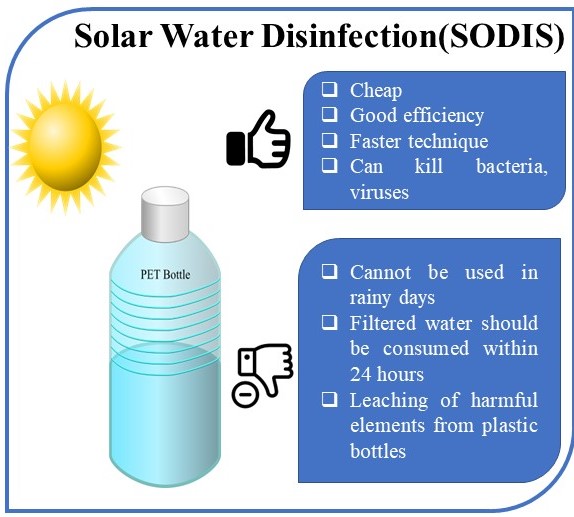By Sakshi Kabra Malpani, Publishing Associate: Researcher and Writer at Save the Water™ | October 19, 2022.
SODIS is a World Health Organization (WHO)-approved, cheap, old-school process commonly used for domestic water treatment. It does not change the taste of water. The USA is one of the top countries in the world publishing research in this growing area of interest.
More About SODIS
SODIS is basically an environment-dependent, repeatable process. We can start it at our home by using ordinary plastic bottles or containers. It is mainly used in areas where sunlight is abundant. Ultraviolet (UV) rays of sunlight can effectively kill viruses and microorganisms like E. coli present in contaminated water which are even resistant to chlorination. These rays inactivate and damage cells of microorganisms, thus, preventing them from multiplying further. Additionally, such microorganisms cause various water-borne diseases like typhoid, dysentery, fever, intestinal infection, and many more. Water is treated and stored in the same container, hence it is an overall cheap, less time-consuming, space-occupying technique with fewer chances of recontamination.
How Does it Work?
SODIS works by using UV-A and infrared (IR) radiations of sunlight altogether. Initially, UV-A radiations damage living cells of microorganisms. After that, when temperature of water rises to 70-75 °C, IR rays help in thermal disinfection, or pasteurization of water. Therefore, the overall efficiency of the process increases. Since microorganisms are extremely sensitive to heat, they do not survive in these specific conditions.
This method appeared to be better at killing microorganisms in water, when compared with other traditional water treatment techniques like chlorination, filtration, ozonation, electroflocculation, advanced oxidation, and others. Besides, it does not produce harmful by-products and certainly is way cheaper.
| Name of water treatment techniques | Amount spent in $ (Per person per year) |
| SODIS | 0.63 |
| Chlorination | 0.66 |
| Filtration | 3.03 |
| Electroflocculation | 4.95 |
Time Taken by SODIS
Sunny days- 6 hours.
Cloudy days- 48 hours.
Not favorable during rainy days.
If the turbidity of contaminated water is high, then the period of SODIS treatment extends.
Some Real-world Examples
- Lexington, KY, USA: Environmental Research Training Laboratory (ERTL) at the University of Kentucky conducted some experiments to study the feasibility of SODIS in removing E. coli from turbid water at temperature less than 50 °C. When the turbidity of water was increased from 30 to 200 Nephelometric Turbidity Unit (NTU), the efficiency of SODIS in killing microorganisms decreased accordingly.
- Ecuador and Bolivia: Jonathan Spear & Valerie Grosscup, The Colorado College, USA, helped about 35 communities and more than 3,500 people on the northern coast of Ecuador with their seven-week SODIS project. Engineers Without Borders (EWB)-USA has run the SODIS project to improve water quality in rural communities of Bolivia. Missouri University of Science and Technology conducted SODIS experiments, under sunny and cloudy weather conditions. Later, it was concluded that on sunny days, E. coli were completely removed from water while on cloudy days, only 50% were removed efficiently.
Advantages of SODIS
- SODIS not only improves the microbiological quality of drinking water but also reduces cases of waterborne diseases, thereby supporting human health.
- It is affordable, simple, and replicable technique because it depends on sunlight, a renewable source of energy.
- The use of traditional heating sources like coal, fuel, and wood is not involved, thus reducing environmental pollution.
- The chance of recontamination is low if purified water is consumed within 24 hours.
- It does not require huge machinery or costly infrastructure, and it can be started at home with plastic bottles.
Limitations of SODIS
- SODIS requires sufficient sunlight. For that reason, its use chiefly depends on the weather and climatic conditions.
- It cannot be used for very dirty, turbid water.
- It is not useful for treating large volumes of water.
- In unfavorable weather conditions, SODIS requires more time to treat water.
- Plastic containers used in the SODIS technique get contaminated, causing leaching of harmful elements and associated health problems, if used for long periods.
- It cannot treat non-biological impurities in water.
Solutions to the Problems
- To avoid the harmful effect of plastic bottles, alternative materials could be containers made of glass, polypropylene, polycarbonate, polyethylene, and others.
- Carbonates and bicarbonates dissolved in water absorb UV radiations and do not disturb the process.
- Use of mirrors, solar collectors concentrate solar radiations, consequently process efficiency increases significantly.
- The bottom part of SODIS containers can be painted black, so that higher temperatures can be maintained inside.
- Integration of photocatalysts, pretreatment of water (use of natural coagulants and adsorbents), and the use of continuous flow-based systems can enhance the efficiency of SODIS.
What Can You Do to Support SODIS?
SODIS is indeed getting more popular, as the amount of research on it has been increasing every year. These studies suggest that SODIS can be used worldwide to treat water irrespective of weather conditions, as it worked well even in the colder climate of Finland. This cheap, low-tech process can also treat harvested rainwater in poor regions. With this in mind, more investigations are required to estimate all the design and control parameters for SODIS treatment of water. Not to mention, we can break social barriers to this technique by publicizing this practice even more at the community level.




